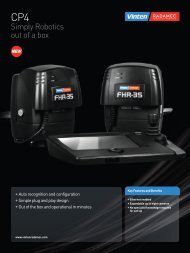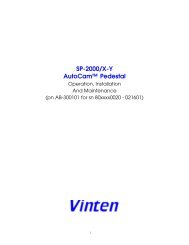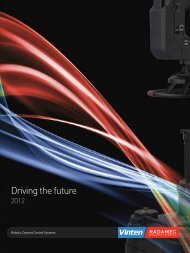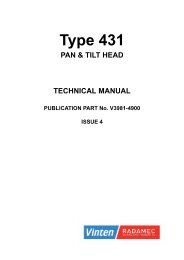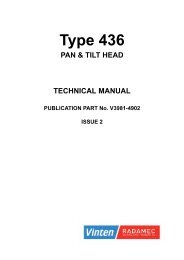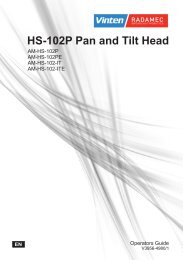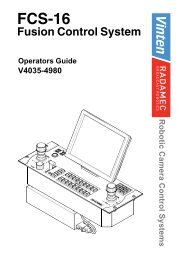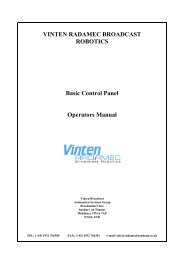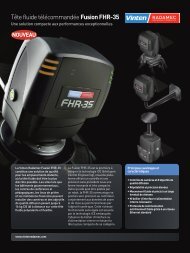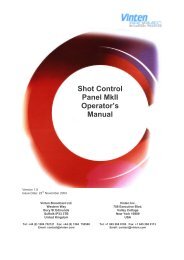HS-105P, PE. SA AutoCam™ Pan & Tilt Head - Vinten Radamec
HS-105P, PE. SA AutoCam™ Pan & Tilt Head - Vinten Radamec
HS-105P, PE. SA AutoCam™ Pan & Tilt Head - Vinten Radamec
You also want an ePaper? Increase the reach of your titles
YUMPU automatically turns print PDFs into web optimized ePapers that Google loves.
<strong>HS</strong>-<strong>105P</strong> Safety & Introduction<br />
If the direct line of sight is obstructed in your installation, it is recommended<br />
that one or more viewing cameras (e.g. security type cameras) are installed to<br />
cover the active areas and allow the operator to view the entire work-space at all<br />
times.<br />
Operating Footprint And Safe Operating Zone<br />
The operating footprint must take into account the overhang of any payload<br />
equipment mounted on the <strong>HS</strong>-<strong>105P</strong>. In particular, the payload element that protrudes<br />
the most defines the operating footprint area as the head pans and tilts.<br />
If your operating practices require personnel to work less than 3 feet (1m) outside<br />
the operating footprint, you must make sure that they are trained and are<br />
aware of the hazards of working in a robot environment, including the specific<br />
hazards listed below. The forces are sufficient to cause personal injury, or injury<br />
to others and therefore, caution is essential.<br />
Warning Signs<br />
Warning signs should be displayed prominently in the workplace as a reminder<br />
to trained personnel, and a primary warning to untrained personnel and visitors.<br />
A typical sign might read:<br />
WARNING:<br />
Robotic heads and lenses move suddenly without warning<br />
Keep a MINIMUM of 3 feet from active heads at all times<br />
<strong>Head</strong>s Can Start Unexpectedly<br />
The hazards associated with robotic camera systems are only slightly different<br />
than those associated with operating a camera under conventional manual control.<br />
The speeds and camera weights are similar. The main difference is that with<br />
automation, the operator is normally not near the cameras, and it is more difficult<br />
to verify that the area is clear. For personnel working on or near the robotic<br />
heads, they must be aware that the equipment can start moving unexpectedly.<br />
All personnel should be trained and aware of the hazards of robotic heads, and<br />
the fact that they can move at any time. They must be trained on how far the<br />
heads and payloads can move, the speeds involved, and the need to stay back an<br />
appropriate distance.<br />
Most adjustments to the camera and head, such as tilt balancing and camera<br />
video adjustments, should be made with the system de-energized. However, if<br />
adjustments are absolutely necessary while the head is powered, they should<br />
only be made by trained technical personnel familiar with the AutoCam robotics<br />
system. They must understand that the camera can move unexpectedly at any<br />
time, and must position themselves so that any motion would not cause them<br />
personal harm.<br />
User Manual 1-3



